In the ever-evolving landscape of cybersecurity, a new and particularly deceptive threat is gaining momentum: deepfakes. Once the subject of internet fascination, deepfake technology, which uses artificial intelligence to create highly realistic but entirely fabricated videos and audio, has now emerged as a potent tool for cyber criminals. For businesses, the implications are significant, turning what you see and hear into a potential security risk.
The core danger of deepfakes lies in their ability to convincingly impersonate trusted individuals. Imagine receiving a video call from your CEO, their voice and face perfectly replicated, urgently instructing you to process a large transfer to a new supplier. The request seems legitimate, the pressure is on, and the visual confirmation is compelling. This is no longer a hypothetical scenario; it is an advanced form of social engineering that can bypass traditional security checks by exploiting human trust.
How Deepfakes Can Impact Your Organisation
The potential for misuse in a professional environment is broad and concerning. Attackers can leverage this technology in several malicious ways:
- Financial Fraud: As in the scenario above, deepfakes can be used to impersonate executives or financial controllers to authorise fraudulent transactions, tricking employees into sending money directly to criminals.
- Reputation Sabotage: An attacker could create a deepfake video of a board member making inflammatory remarks or leaking false “insider” information. The resulting damage to brand reputation, customer trust, and even stock value could be catastrophic.
- Corporate Espionage: Imagine a deepfake video call where a “manager” from another department asks an employee to share sensitive project files or access credentials. By convincingly mimicking a trusted colleague, attackers can gain access to valuable intellectual property.
- Blackmail and Extortion: Malicious actors could generate compromising or professionally damaging videos of key personnel and use them for extortion, demanding payment to prevent the video’s release.
Relying on Your Eyes Is No Longer Enough
While early deepfakes had tell-tale signs of manipulation, the technology is advancing at a rapid pace. Flaws like unnatural blinking or poor lip-syncing are becoming far less common. Relying solely on human perception to identify a sophisticated deepfake is an unreliable and high-risk strategy.
The real defence lies not in trying to outsmart the technology with a closer look, but in building procedural resilience against it.
Ahead of the Threat: A Proactive Defence
The most effective way to counter the threat of deepfakes is to have clear and robust internal processes.
At Vertex, we recognise that staying ahead of emerging threats like deepfakes is paramount. We believe that great cyber security requires thinking beyond today’s attacks and preparing for the challenges of tomorrow. We understand that technical awareness must be paired with strong internal processes, which is why we have already developed policies and procedures to help businesses detect and respond to the risks posed by deepfake content.
For reference we also asked AI to generate a policy and process on dealing with Deepfakes and the results were a long winded document that would likely not be effective in a real DeepFake situation.
Secure Your Organisation for the Future
Deepfake technology represents a significant shift in the tactics used by cyber criminals. As the line between reality and artificial media blurs, organisations must adapt their security posture accordingly.
Protecting your business from these advanced threats requires forward-thinking and expert guidance. If you are concerned about the risks of deepfakes and other sophisticated cyber attacks, we encourage you to contact Vertex. Our team can help you develop and implement the tailored policies and security frameworks needed to protect your organisation, your employees, and your clients.

